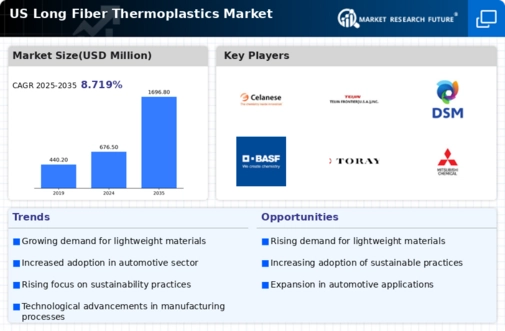The long fiber thermoplastics market is currently characterized by a dynamic competitive landscape, driven by increasing demand for lightweight materials across various industries, including automotive and aerospace. Key players such as BASF (US), Celanese (US), and DuPont (US) are strategically positioned to leverage innovation and sustainability in their operations. BASF (US) focuses on developing advanced materials that enhance performance while reducing environmental impact, whereas Celanese (US) emphasizes digital transformation to optimize production processes. DuPont (US) is actively pursuing partnerships to expand its product offerings, thereby enhancing its competitive edge. Collectively, these strategies contribute to a robust competitive environment, fostering innovation and responsiveness to market needs.
In terms of business tactics, companies are increasingly localizing manufacturing to reduce lead times and enhance supply chain efficiency. The market structure appears moderately fragmented, with several key players exerting influence over their respective segments. This fragmentation allows for niche players to emerge, yet the collective strength of major companies like SABIC (US) and Solvay (US) ensures that competition remains intense. SABIC (US) has been optimizing its supply chain to improve resilience, while Solvay (US) is focusing on sustainable practices to meet evolving regulatory standards.
In November 2025, SABIC (US) announced a strategic partnership with a leading automotive manufacturer to develop next-generation long fiber thermoplastics aimed at enhancing vehicle performance and sustainability. This collaboration is significant as it not only aligns with the growing trend towards lightweight materials but also positions SABIC (US) as a key player in the automotive sector, potentially increasing its market share.
In October 2025, DuPont (US) launched a new line of long fiber thermoplastics designed specifically for the aerospace industry, emphasizing enhanced thermal stability and mechanical properties. This move is crucial as it addresses the increasing demand for high-performance materials in aerospace applications, thereby reinforcing DuPont's commitment to innovation and market leadership.
In September 2025, Celanese (US) unveiled a digital platform aimed at streamlining its production processes and enhancing customer engagement. This initiative reflects a broader trend towards digitalization within the industry, suggesting that companies are increasingly recognizing the importance of technology in maintaining competitive advantage.
As of December 2025, the competitive trends in the long fiber thermoplastics market are heavily influenced by digitalization, sustainability, and the integration of advanced technologies such as AI. Strategic alliances are becoming more prevalent, enabling companies to pool resources and expertise to drive innovation. The competitive landscape is likely to evolve from traditional price-based competition towards a focus on technological advancements, supply chain reliability, and sustainable practices, indicating a shift in how companies differentiate themselves in the market.






















Leave a Comment